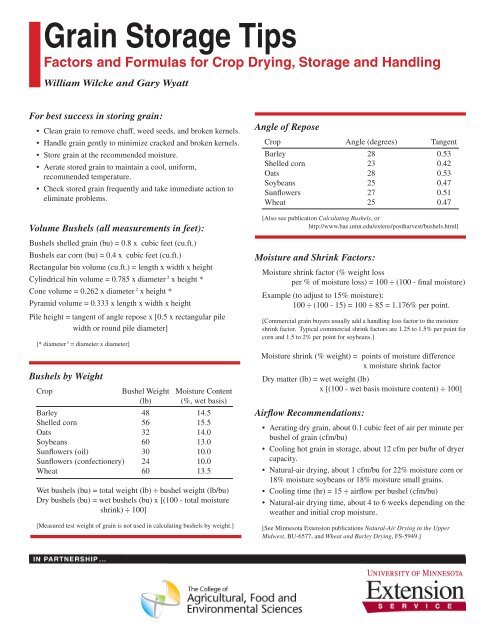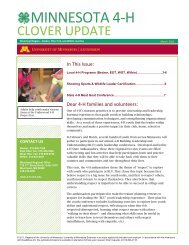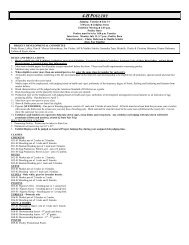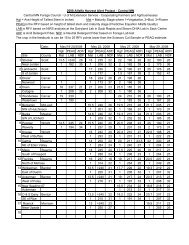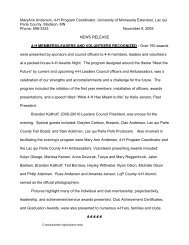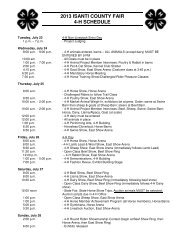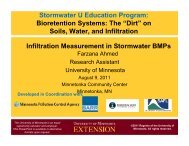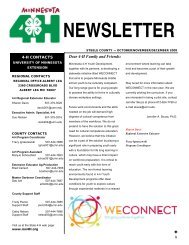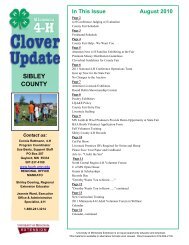Grain Storage Tips - Factors and Formulas for Crop Drying, Storage ...
Grain Storage Tips - Factors and Formulas for Crop Drying, Storage ...
Grain Storage Tips - Factors and Formulas for Crop Drying, Storage ...
Create successful ePaper yourself
Turn your PDF publications into a flip-book with our unique Google optimized e-Paper software.
<strong>Grain</strong> <strong>Storage</strong> <strong>Tips</strong><br />
<strong>Factors</strong> <strong>and</strong> <strong>Formulas</strong> <strong>for</strong> <strong>Crop</strong> <strong>Drying</strong>, <strong>Storage</strong> <strong>and</strong> H<strong>and</strong>ling<br />
William Wilcke <strong>and</strong> Gary Wyatt<br />
For best success in storing grain:<br />
• Clean grain to remove chaff, weed seeds, <strong>and</strong> broken kernels.<br />
• H<strong>and</strong>le grain gently to minimize cracked <strong>and</strong> broken kernels.<br />
• Store grain at the recommended moisture.<br />
• Aerate stored grain to maintain a cool, uni<strong>for</strong>m,<br />
recommended temperature.<br />
• Check stored grain frequently <strong>and</strong> take immediate action to<br />
eliminate problems.<br />
Volume Bushels (all measurements in feet):<br />
Bushels shelled grain (bu) = 0.8 x cubic feet (cu.ft.)<br />
Bushels ear corn (bu) = 0.4 x cubic feet (cu.ft.)<br />
Rectangular bin volume (cu.ft.) = length x width x height<br />
Cylindrical bin volume = 0.785 x diameter 2 x height *<br />
Cone volume = 0.262 x diameter 2 x height *<br />
Pyramid volume = 0.333 x length x width x height<br />
Pile height = tangent of angle repose x [0.5 x rectangular pile<br />
width or round pile diameter]<br />
[* diameter 2 = diameter x diameter]<br />
Bushels by Weight<br />
<strong>Crop</strong> Bushel Weight Moisture Content<br />
(lb) (%, wet basis)<br />
Barley 48 14.5<br />
Shelled corn 56 15.5<br />
Oats 32 14.0<br />
Soybeans 60 13.0<br />
Sunflowers (oil) 30 10.0<br />
Sunflowers (confectionery) 24 10.0<br />
Wheat 60 13.5<br />
Wet bushels (bu) = total weight (lb) ÷ bushel weight (lb/bu)<br />
Dry bushels (bu) = wet bushels (bu) x [(100 - total moisture<br />
shrink) ÷ 100]<br />
[Measured test weight of grain is not used in calculating bushels by weight.]<br />
Angle of Repose<br />
<strong>Crop</strong> Angle (degrees) Tangent<br />
Barley 28 0.53<br />
Shelled corn 23 0.42<br />
Oats 28 0.53<br />
Soybeans 25 0.47<br />
Sunflowers 27 0.51<br />
Wheat 25 0.47<br />
[Also see publication Calculating Bushels, or<br />
http://www.bae.umn.edu/extens/postharvest/bushels.html]<br />
Moisture <strong>and</strong> Shrink <strong>Factors</strong>:<br />
Moisture shrink factor (% weight loss<br />
per % of moisture loss) = 100 ÷ (100 - final moisture)<br />
Example (to adjust to 15% moisture):<br />
100 ÷ (100 - 15) = 100 ÷ 85 = 1.176% per point.<br />
[Commercial grain buyers usually add a h<strong>and</strong>ling loss factor to the moisture<br />
shrink factor. Typical commercial shrink factors are 1.25 to 1.5% per point <strong>for</strong><br />
corn <strong>and</strong> 1.5 to 2% per point <strong>for</strong> soybeans.]<br />
Moisture shrink (% weight) = points of moisture difference<br />
x moisture shrink factor<br />
Dry matter (lb) = wet weight (lb)<br />
x [(100 - wet basis moisture content) ÷ 100]<br />
Airflow Recommendations:<br />
• Aerating dry grain, about 0.1 cubic feet of air per minute per<br />
bushel of grain (cfm/bu)<br />
• Cooling hot grain in storage, about 12 cfm per bu/hr of dryer<br />
capacity.<br />
• Natural-air drying, about 1 cfm/bu <strong>for</strong> 22% moisture corn or<br />
18% moisture soybeans or 18% moisture small grains.<br />
• Cooling time (hr) = 15 ÷ airflow per bushel (cfm/bu)<br />
• Natural-air drying time, about 4 to 6 weeks depending on the<br />
weather <strong>and</strong> initial crop moisture.<br />
[See Minnesota Extension publications Natural-Air <strong>Drying</strong> in the Upper<br />
Midwest, BU-6577, <strong>and</strong> Wheat <strong>and</strong> Barley <strong>Drying</strong>, FS-5949.]
High Temperature <strong>Drying</strong>:<br />
Propane use equals about 0.02 gal/bu per percentage point of<br />
moisture removed.<br />
Keep kernel temperature under 110°F to preserve germination,<br />
under 140°F to preserve milling quality.<br />
Fan Power Requirement:<br />
Depends on airflow, grain type <strong>and</strong> grain depth.<br />
[See the Minnesota Extension publication Selecting Fans <strong>and</strong> Determining<br />
Airflow <strong>for</strong> <strong>Crop</strong> <strong>Drying</strong>, Cooling <strong>and</strong> <strong>Storage</strong>, FO-5716. A computer<br />
program is also available <strong>for</strong> download in the “Biosystems <strong>and</strong> Agricultural<br />
Engineering Department Materials” software section of:<br />
http://www.bae.umn.edu/extens/postharvest/]<br />
Recommended Vent <strong>and</strong> Duct Sizes:<br />
Bin roofs should have about 1 square foot of open area per<br />
1,000 cubic feet per minute (cfm) of airflow. Add roof vents if<br />
the gap at eaves <strong>and</strong> the hatches open during fan operation do<br />
not provide enough area.<br />
Provide 1 square foot of duct cross-sectional area per 1,500<br />
cfm of airflow.<br />
Cross-sectional area <strong>for</strong> round ducts (sq. ft.)<br />
= 0.00545 x diameter (in.) x diameter (in.)<br />
Cross sectional area <strong>for</strong> common round duct sizes:<br />
Diameter (inches) 12 18 24<br />
Area (square feet) 0.78 1.77 3.14<br />
Recommended <strong>Storage</strong> Temperature <strong>and</strong> Moisture:<br />
Keep grain temperature less than 50°F at all times of the year.<br />
In the upper Midwest, aerate to cool grain to 20° to 30°F <strong>for</strong><br />
winter storage.<br />
Equilibrium Moisture Values<br />
Recommended <strong>Storage</strong> Moisture<br />
(percent wet basis <strong>for</strong> clean, aerated grain crops)<br />
–———— <strong>Storage</strong> Time ——–——<br />
Up to 6 Months More than 6 Months<br />
Corn 15 13<br />
Soybeans 13 11<br />
Canola 15 13<br />
Edible beans 15 13<br />
Small grains 14 13<br />
Sunflower (oil) 10 8<br />
Recommended Spout <strong>and</strong> Floor Angles<br />
Angle with horizontal (degrees) required <strong>for</strong> gravity flow on<br />
sloped surfaces:<br />
Material Angle (degrees)<br />
<strong>Grain</strong> (dry, cool) 37<br />
<strong>Grain</strong> (wet, hot) 45<br />
Ground feed or meal 60<br />
Pellets 45<br />
Sunflowers 60<br />
Maximum storage time in months <strong>for</strong> shelled corn *<br />
Corn Corn Moisture Content<br />
Temp. 13% 14% 15% 16% 17% 18%<br />
40°F 150 61 29.0 15.0 9.5 6.1<br />
50°F 84 34 16.0 8.9 5.3 3.5<br />
60°F 47 19 9.2 5.0 3.0 1.9<br />
70°F 26 11 5.2 2.8 1.7 1.1<br />
80°F 15 6 2.9 1.6 0.9 0.9<br />
[*Based on 0.5% maximum dry matter loss – calculated on the basis of USDA<br />
research at Iowa State University.]<br />
Moisture content (% wet basis) <strong>for</strong> crops exposed to air at various temperatures <strong>and</strong> relative humidities.<br />
————————–––––——— Relative Humidity ———–—–————————<br />
Temperature 20 % 40 % 60 % 80 %<br />
(°F) C W SB C W SB C W SB C W SB<br />
40 9.2 8.5 4.6 11.9 11.7 8.1 14.5 14.6 11.5 17.9 18.0 16.0<br />
50 8.5 8.2 4.2 11.2 11.3 7.8 13.8 14.2 11.2 17.3 17.4 15.7<br />
60 7.9 7.9 3.9 10.6 11.0 7.5 13.3 13.7 11.0 16.8 16.9 15.4<br />
70 7.3 7.7 3.6 10.0 10.7 7.2 12.7 13.3 10.7 16.3 16.5 15.2<br />
80 6.7 7.5 3.3 9.6 10.4 6.9 12.3 13.0 10.4 15.9 16.0 15.0<br />
[C = shelled yellow dent corn; W = hard red spring wheat; SB = soybeans]<br />
Copyright © 2002, Regents of the University of Minnesota. All rights reserved. May 2002 / FS-M1080<br />
Produced by Larry Etkin, in the Communication <strong>and</strong> Educational Technology Services unit of the University of Minnesota Extension Service.<br />
The University of Minnesota Extension Service is an equal opportunity educator <strong>and</strong> employer. The in<strong>for</strong>mation given in this publication is <strong>for</strong> educational<br />
purposes only. In accordance with the Americans with Disabilities Act, this material is available in alternative <strong>for</strong>mats upon request. Please contact your<br />
University of Minnesota Extension Service county office or, outside of Minnesota, contact the Distribution Center at (800) 876-8636.<br />
For more University of Minnesota Extension Service educational in<strong>for</strong>mation, log on to: www.extension.umn.edu


